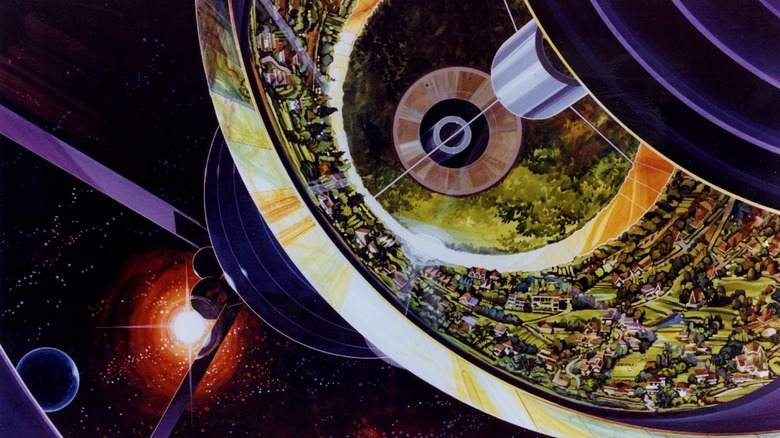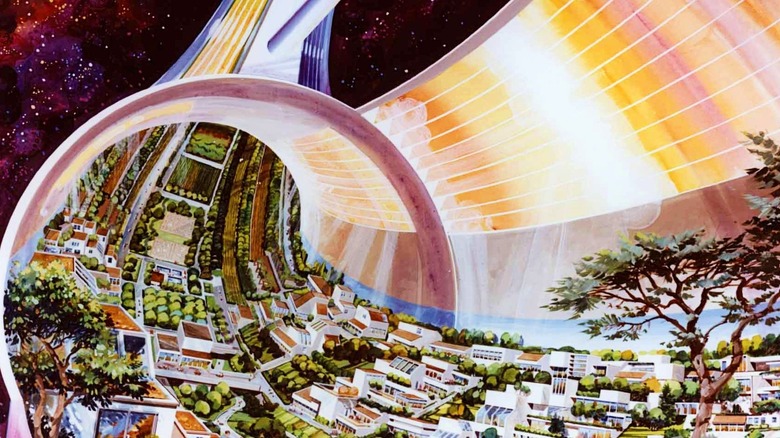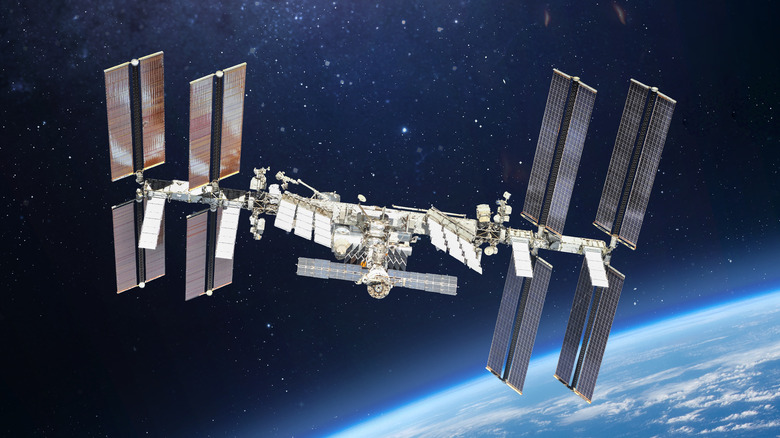Here's What NASA's Vision For The Future Looked Like In 1975
When we think about future space colonies, images of large, rotating, sphere-shaped spacecraft with artificial gravity come to mind. These visualizations are not random — they have been presented by NASA, the space sector, and science fiction writers for decades. As the International Space Station — the closest thing humanity has today to a colony in space – approaches its end of life, new space stations begin to take shape. Axiom Space, for example, is building new modules for the ISS that will later detach and expand to create a new and more modern space station (via Axiom Space).
On December 21, 2021, Blue Origin announced NASA had also selected Orbital Reef — with Blue Origin, Sierra Space, and Boeing as partners — to build another space station in low Earth orbit. These new space stations, which will replace the ISS, have much more spacious work and living quarters, are open to private participation, promise innovative manufacturing and research in space, and will even accommodate space tourists. However, none of these stations are as massive and ambitious as the concepts NASA published in the 1970s.
NASA and Stanford imagined the Torus habitat
The National Space Society has published a NASA video from 1975 that presents the agency's space colony concept. The Apollo missions had just ended, and Americans had conquered the moon. The "what's next?" question was on everyone's mind, fueling speculation over whether NASA would go to Mars for its next mission or instead build a city in space. The latter idea was fueled by the Torus project.
The Stanford Torus concept was a design for a habitat that could house 10,000 residents in space, according to the companion paper "Space Settlements: A Design Study." The concept imagined a massive wheel-like structure a mile wide in a fixed, stable position between the Earth and the moon that would slowly spin at one revolution per minute to generate artificial gravity. People inside the city would be able to grow crops and maximize solar energy while mirrors would reflect deadly radiation. The materials to build the city would be sourced from the moon, and industries in the city would flourish with solar power — or, at least, that's what the concept envisioned.
The idea was not new. Wernher von Braun, a leading figure in NASA's early days, presented similar concepts for space stations with artificial gravity in 1952 (via Internet Archive.org). Though the idea to build a space habitat eventually won over a mission to Mars, the resulting station is nothing like these early, ambitious concepts.
The ISS is a step toward more ambitious goals
NASA explains that before the ISS, the first U.S. space station, Skylab, demonstrated that humans could live in space for up to a year. Skylab became a space outpost from 1973 to 1974. During those years, the U.S. and Russia kickstarted their space collaboration with the first docking between a Russian and a U.S. spacecraft: the Apollo-Soyuz Mission. The collaboration would persist through the Space Shuttle era and to the construction and eventual operation of the ISS. Unlike the early habitat concepts, however, the ISS lacks artificial gravity. Why?
In a NASA podcast, Bill Paloski, former NASA director of the Human Research Program, explains that the costs were too high and the effects of microgravity were not yet fully understood. Programs to countermeasure the effects microgravity had on the human body, like exercise routines, which astronauts still today do on the ISS, were an affordable solution. The complex engineering and costly challenge of building a space station with an artificial gravity system stood no chance against the cheap exercise machines. Paloski worked for NASA on different artificial gravity development programs that spanned from the '50s to the '90s
The NASA expert believed artificial gravity is key for the future of space exploration, however. Without microgravity countermeasures or artificial gravity spacecraft and space structures, humans will not be able to explore Mars, build the Artemis base on the moon, or continue living in space stations. It remains to be seen whether future space colonies end up mirroring these old ideas — gravity included — or if new innovations will take them in directions that haven't yet been imagined.


